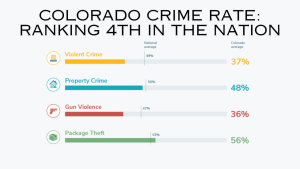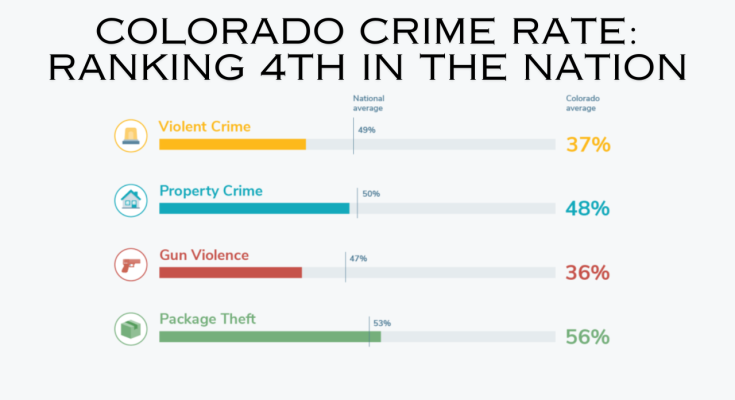Introduction Colorado Crime Rate:
Colorado, known for its stunning landscapes and vibrant communities, is facing a concerning trend – a rising crime rate that now ranks 4th in the nation. This shift has prompted discussions about public safety, law enforcement strategies, and the underlying factors contributing to the increase in criminal activity. In this article, we’ll explore the nuances of Colorado crime rate, its implications for residents and policymakers, and potential strategies for addressing this challenge.
The Scope of Colorado Crime Rate:
In recent years, Colorado has experienced a notable uptick in various categories of crime, ranging from property crimes to violent offenses. According to recent statistics, the state’s overall crime rate has risen significantly, leading to its ranking as the 4th highest in the nation. Understanding the factors driving this increase is essential for devising effective solutions and ensuring the safety and well-being of Colorado’s residents.

Read More Article :South Dakota End of Fiscal Year 2021
Factors Contributing to the Rise in Crime:
Several factors may be contributing to Colorado’s rising crime rate:
- Population Growth: Colorado has experienced rapid population growth in recent years, driven by factors such as job opportunities, quality of life, and a thriving economy. While population growth brings many benefits, it can also strain resources and infrastructure, potentially leading to an increase in crime rates.
- Socioeconomic Factors: Economic disparities, poverty, and lack of access to education and employment opportunities can contribute to criminal behavior. Areas experiencing higher levels of socioeconomic disadvantage may be more susceptible to crime, as individuals may resort to illegal activities out of desperation or necessity.
- Drug and Substance Abuse: Substance abuse, including the misuse of opioids and other drugs, can fuel criminal activity such as drug trafficking, theft, and violence. Colorado, like many other states, has grappled with substance abuse issues, which may be exacerbating its crime rate.
- Mental Health Challenges: Individuals struggling with mental health issues may be at a higher risk of engaging in criminal behavior, particularly if they lack access to proper treatment and support services. Colorado’s approach to addressing mental health needs within its communities can impact crime rates and public safety outcomes.
Impact on Communities and Residents:
The rising crime rate in Colorado has significant implications for communities and residents across the state:
- Safety Concerns: Concerns about safety and security may heighten among residents, impacting their quality of life and sense of well-being. Addressing these concerns requires proactive measures to prevent crime, apprehend offenders, and promote community engagement and collaboration.
- Economic Effects: High crime rates can deter businesses and investors from establishing roots in affected areas, limiting economic growth and development opportunities. Additionally, property crime and theft can result in financial losses for businesses and homeowners, further straining local economies.
- Trust in Law Enforcement: Public perceptions of law enforcement effectiveness and accountability may be influenced by the response to rising crime rates. Building and maintaining trust between law enforcement agencies and the communities they serve is crucial for effective crime prevention and response efforts.
Strategies for Addressing the Challenge:
Addressing Colorado’s rising crime rate requires a multifaceted approach that addresses root causes while enhancing law enforcement capabilities and community partnerships:
- Prevention and Intervention: Investing in programs and initiatives that address underlying social and economic factors contributing to crime can help prevent criminal behavior before it occurs. This includes initiatives focused on education, employment, mental health, and substance abuse treatment.
- Law Enforcement Strategies: Enhancing law enforcement capabilities, including staffing, training, and technology, can improve crime prevention, investigation, and apprehension efforts. Implementing community policing strategies that prioritize collaboration and engagement with residents can also enhance trust and cooperation.
- Rehabilitation and Reintegration: Supporting efforts to rehabilitate and reintegrate individuals who have engaged in criminal behavior can reduce recidivism and promote community safety. This includes providing access to education, vocational training, and support services to help individuals successfully transition back into society.
Conclusion Colorado Crime Rate:
Colorado’s rising crime rate presents a complex challenge that requires coordinated efforts from government agencies, law enforcement, community organizations, and residents. By understanding the factors driving the increase in crime and implementing strategies focused on prevention, intervention, and rehabilitation, Colorado can work toward improving public safety and enhancing the well-being of its communities.
Read More Interesting Article : Understanding Colorado Crime Rate: Ranking 4th in the Nation




